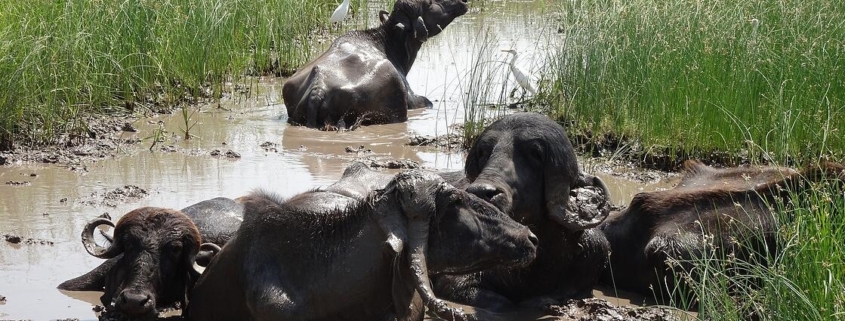
More moor! Don’t waste a wasteland. – Paludiculture for innovation and nature protection
Background: Paludiculture protects marshlands and its ecological benefits
In the course of a potential analysis for Wilstermarsch, a region near the Elbe estuary which has the lowest point in Germany (-3.54 m), BE Solutions GmbH has developed numerous application examples for paludiculture on marshland and moor locations in the sense of a cascading economy.
Moor is a special landscape, which offers a huge variety of ecosystem services and plays a decisive role in terms of climate and environmental protection, despite its small area.
It has shaped human life for many centuries. Not only the techniques of cultivating it, but our language and literature were also influenced to a large extent by moor lanscapes. Moors are water-saturated soils that do not or only incompletely decompose dead organic material due to a lack of oxygen. Therefore, the production of organic substances is faster than their breakdown. This particular landscape provides society and humans with a range of important ecosystem services. Especially in the current debate about effective climate protection measures, the preservation and renaturation of bogs must be an essential component as they remove 150 to 250 million tons of CO2 worldwide every year from the atmosphere and thus act as a carbon sink. The CO2 absorbed by the plants during their growth is stored in the peat after they die. In the course of many millennia peatlands have developed into gigantic carbon stores. Although they only cover 3% of the earth’s surface, they bind a third of the carbon in their peat layers, about twice as much as all forests worldwide in their biomass.
Innovation: Products of paludiculture
Germany has numerous fens. Such locations in particular should be managed in an alternative way that maintains or builds up moor and continues to cultivate it despite the subsoil. When it comes to the utilization and renaturation of moors, we speak of so-called paludiculture.
Rewetted moors are usually heavily degraded and mineralized sites with compacted and poorly permeable peat. Following the rewetting of those moors with groundwater levels near the surface, they are usually populated by a few dominant marsh plants. However, depending on the hydrological conditions alder forest, cattail, reed, large sedge, broken shrubbery or sweet grass reed can also be expected as potentially natural vegetation. Yet, not only plants but also animals like the water buffalo can habitat a paludiculture. Due to their special claw physiology, they are mostly used for landscape maintenance. Additionally, their milk can be processed in to buffalo mozzarella.
Plants that can be used in paludiculture are wetland plants that can provide useful biomass in good quality and quantity and at the same time contribute to peat conservation and therefor make a valuable contribution to climate protection. An assessment for northern Germany showed that a quarter of a total of 830,000 hectares of peat bogs could be cultivated for BRP production (biomass from rewetted peatlands). With a yield of 10 tons per hectare and per year, around 20 million tons of dry biomass are available, which would correspond to the output of 20 biomass combustion plants with a capacity of 20 MW each.
Potential: Environmental and economic protection
The basic principle of all paludiculture processes is the production and harvest of marketable raw materials under permanently wet conditions with underlying peat maintenance or peat formation. Paludiculture is currently the only form of management that makes this possible. In contrast to the conventional use of fens, paludiculture can thus combine three properties: They make a contribution to climate protection, maintain the agricultural production areas over the long term and enable the production of renewable raw materials. If paludiculture is created for the purpose of climate protection, highly productive or peat-forming helophytes (swamp plants) should preferably be used.
Paludiculture is incredibly versatile. They can be used and sold in various sectors, such as the construction industry, healthcare, agriculture and the energy sector. The greatest output of added value comes from the cultivation of ecological building materials such as reed – a plant that has long been cultivated in northern Germany and used for thatched roofs.
This could also be interesting for you: Green energy from algae.
References
Research proposal from BE Solutions with the community of Wilstermarsch



